It is believed that cause of tooth mobility is periodontal disease. In many cases, however, the opposite is true. There are many reasons why adults have loose teeth. They may relate directly to the field of dentistry, or may be the consequences of other human diseases.
Record content:
- 1 What are the causes of loose teeth in adults?
- 2 When are healthy teeth loose?
- 3 Degree of mobility
- 4 In what cases is it possible to save a tooth?
- 5 Diagnostics
-
6 Treatment activities
- 6.1 Gum treatment
- 6.2 Cyst treatment
- 6.3 Splinting
- 6.4 Strengthening teeth with bruxism
- 6.5 Gum massage
- 6.6 Folk remedies
- 7 Dental Disease Videos
What are the causes of loose teeth in adults?
Normally, the teeth are characterized by a small degree of mobility, which is hardly, or practically imperceptible on palpation. An increase in the radius of loosening means the presence of physical or functional impairments that can affect both the field of dentistry and other branches of medicine. In this case, a complete absence of painful symptoms is possible, which may not appear for a long time.
Periodontitis is considered to be the main cause of loosening of teeth. However, often the opposite happens - violation of the natural position of the tooth leads to inflammation of the periodontal tissues. This is what provokes the onset of soreness, swelling and bleeding of the gums, as well as other unpleasant symptoms.
In addition to periodontitis, pathological tooth mobility can lead to:
-
periodontitis. This is an inflammation of the root tissues, which leads to the destruction of the connective tissue ligament between the tooth and the alveolar ridge (hole) of the jaw. It occurs due to the penetration of infection from the outside through the root canal. This can occur as a result of untreated caries, or improper placement of a filling or crown;
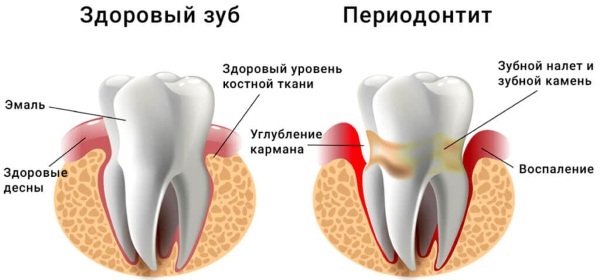
- cyst. Occurs at the root of the tooth. The fluid accumulated inside the tumor has no exit paths, which can provoke an inflammatory process, accompanied by a high temperature. Most often, the tooth begins to loosen more strongly with complications of the granuloma cyst, when pus begins to accumulate in the cavity and immediate surgical intervention is required;
- flux. The accumulation of pus in the periosteum of the tooth, which occurs as a result of a running infectious process.
All these diseases lead to a violation of the integrity of soft tissues and an increase in the alveolar space around the tooth, which leads to a decrease in its stability.
When are healthy teeth loose?
Teeth mobility can occur not only due to inflammatory processes in one's own and adjacent tissues, but also as a result of functional impairment. other organs and systems:
- improper distribution of the load on the jaw. It occurs as a result of malocclusion, loss of teeth, their systemic destruction, due to repeated filling and unproductive treatment. The phenomenon of bruxism, an uncontrolled grinding of teeth, also leads to loosening of the teeth;
- injuries, bruises. They can lead to rupture of the connective ligament of the tooth and tissues holding it in the jaw cell. With timely provision of measures, the tooth can grow back together;
- chronic systemic diseases. Arthrosis, osteoporosis and other diseases of the musculoskeletal system. The cause may be diabetes mellitus, as a result of which the gums are damaged and their elasticity and functionality are lost;
- deficiency of intake and exchange of essential macro- and microelementsas well as vitamins. In particular, a violation of calcium metabolism. May occur temporarily during pregnancy and lactation;
- reduced immunity.
In such cases, it is possible to restore the stability of the tooth only by comprehensive treatment of the root cause of the disease.
Degree of mobility
The teeth of an adult are loose (the reasons are given and discussed in detail in the article) not only due to the disease. Allocate physiological tooth mobility and pathological.
In the first case, the movement is not visible to the naked eye and is a variant of the norm. It is necessary for amortization and is due to the work of the ligamentous apparatus. In the second case, the movement becomes more noticeable and is often a sign of the disease.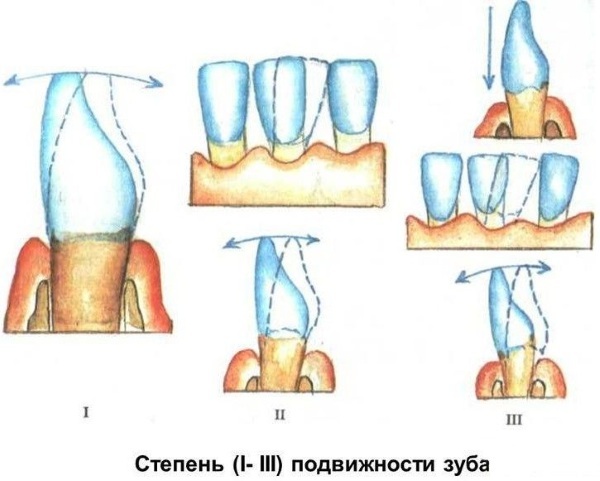
Pathological mobility can be expressed in different ways, and is classified into several degrees:
- I - when pressed, the tooth is displaced by less than 1 mm relative to adjacent crowns in the anteroposterior direction (vestibular-oral);
- II - the tooth is displaced by more than 1 mm and may slightly move laterally;
- III - the tooth noticeably moves in several directions and, when pressed, may slightly sink into the gum;
- IV - the tooth can rotate around its axis.
The most accurate way to determine the degree of tooth mobility is to calculate the reactivity index using special sensors used in dentistry.
In what cases is it possible to save a tooth?
In many cases, a timely visit to the dentist increases the chances of saving the tooth. If he has acquired mobility as a result of a bruise or injury, it is necessary to keep the tooth at rest, without exerting the slightest pressure before visiting a specialist.
In such cases, a special splint or other fixing devices are applied and additional drug therapy is prescribed.
The following symptoms are also a reason to consult a dentist:
- tangible mobility of the tooth relative to the rest;
- soreness to touch / pressure;
- redness / swelling of the gums;
- bleeding gums;
- purulent discharge from the tooth (accompanied by an unpleasant odor).
If at least one of the listed signs is present, you must contact a specialist in a timely manner. This will help not only save the tooth, but also prevent further complications of the disease.
Diagnostics
An adult's teeth are loose (the dentist will help determine the reasons), often with dental problems. If during the initial examination no visible defects were found, then they resort to radiography, and in some cases to tomography.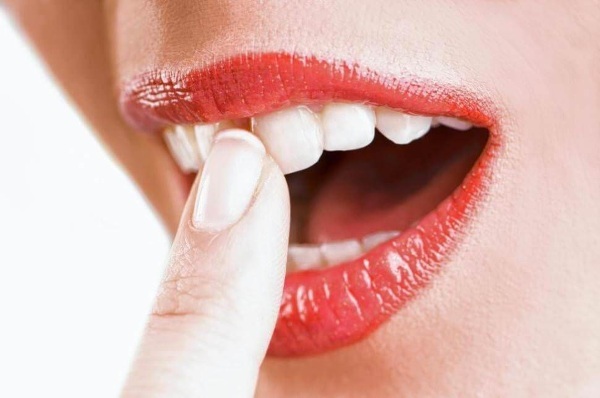
Since the cause of the disease may be outside the competence of dentistry, to identify it, you will need to consult a specialist of another profile - an endocrinologist, an oncologist, a geneticist.
Treatment activities
It is possible to save loose teeth in case of damage or defects in the dentoalveolar complex using various methods. A specialized specialist will help you choose a specific one after a preliminary diagnosis of the disease.
Gum treatment
The most common cause of tooth mobility is gum disease. If signs such as swelling, inflammation, or bleeding appear, you should contact your dentist or periodontist in order to prescribe adequate treatment.
The range of methods is wide enough and depends on the diagnosis:
- professional cleaning. Removal of plaque and deposits on the teeth using special equipment. Sandblasting removes soft plaque and restores natural color to teeth. Ultrasonic - removes deposits of any complexity and is the most effective;
- treatment with Varius and Vector ultrasound devices. With their help, even the hardest plaque is removed, cleaning the crown, tooth neck and periodontal pockets. They are used for gingivitis and periodontitis at any stage;
-
drug therapy. It is prescribed in addition to professional treatment and has a supportive effect. These are solutions and gels used to relieve gum inflammation and provide an antimicrobial effect (see table below).
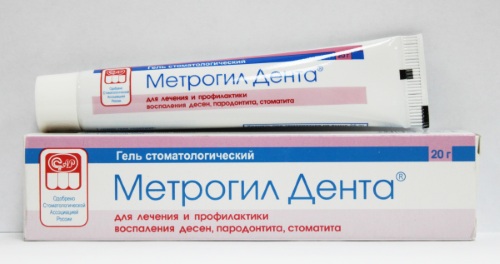
| Name | Indications | Contraindications | Dose |
| Cholisal (choline salicylate, cetalkonium chloride) |
|
sensitivity to drug components | a strip of gel 0.5 cm in size for children and 1 cm for adults is squeezed onto the finger and applied with light massaging movements 2-3 times a day. |
| Metrogyl-denta (metronidazole, chlorhexidine) | inflammatory diseases of the periodontal and mucous membranes, including infectious etiology. |
|
apply a thin strip of gel with your finger, or with a cotton swab 2-3 times a day after meals, or 30 minutes before it. |
| Asepta (metronidazole, chlorhexidine, menthol, mint) |
|
|
the balm is applied with a special spatula 2-3 times a day with a thin layer. |
| Solcoseryl (lauromacrogol) | to accelerate the healing of tissues with gingivitis, stomatitis, seizures and other lesions of the gums and mucous membranes. | hypersensitivity | apply a 0.5 cm strip of gel 3-5 times a day. After application, lightly moisten with water. |
| Stomatofit (herbal extract) | inflammatory diseases of the oral cavity. | hypersensitivity reaction | apply with a cotton swab 2-3 times a day. |
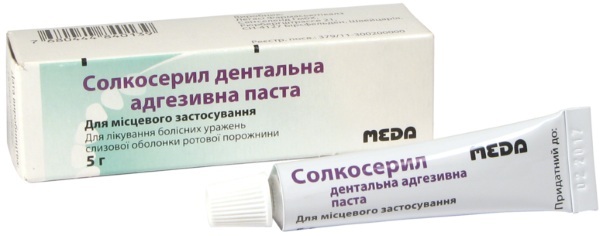
Teeth loose in adults is often due to non-observance of basic measures for oral hygiene. In the later stages of gingivitis and periodontal disease, when there is a risk of not only tooth loss, but also further infection of the deep tissues, surgical intervention is necessary.
Cyst treatment
The appearance of a neoplasm at the root of the tooth does not always immediately make itself felt. At first, it may be asymptomatic, therefore, timely detection and treatment with a dentist increases the chances of saving the tooth.
Cyst treatment is carried out in several ways:
- therapeutic. It is indicated for small cysts, which can be reached through the dental canal. To do this, a hole is made in the tooth, the canal is depulpated with the formation of a course through which the contents of the cyst are discharged to the outside. Then an agent that destroys the cystic membrane is introduced, the tooth is treated with an antiseptic and a temporary filling is placed until the neoplasm is completely resorbed;
- surgical. Through an incision in the gum, the cyst is removed along with the apex of the root. In advanced cases, the root and even part of the tooth must be removed;
- laser. A laser is directed into the open dental canals, which acts on the membrane of the cyst and has a disinfecting effect. Modern technology allows you to remove the neoplasm without blood and pain.
The choice of treatment depends on the results of radiography and the condition of the bone tissue.
Splinting
With significant tooth mobility, characteristic of moderate and severe periodontitis, strengthening with splinting is shown.
The procedure is performed according to several methods using different materials:
-
reinforced with fiberglass. A small groove is made along the entire row of damaged teeth, no more than 2 mm deep. On the inside for the bottom row, on the outside for the top. Next, a fiberglass thread is laid in it and filled with a composite. With the help of such a coupling, the teeth become stable and become a single whole. The procedure takes place in one go, and the effectiveness lasts an average of 5 years;
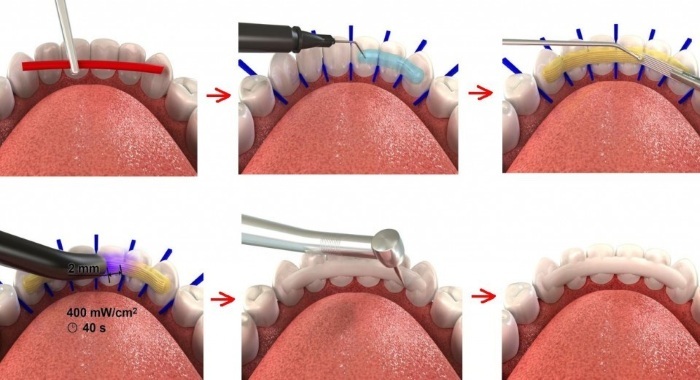
- clasp prostheses. They are prescribed for partial loss of teeth, when fixed prosthetics are not provided. It is a metal arch that bends around the teeth from the inner side of the row. This contributes to the redistribution of the chewing load from the movable teeth to the plate;
- crowns. They are shown in case of tooth mobility with the loss of 4 or more units in a row. The canals are filled, and the outer part of the tooth is sharpened. The crowns welded together are placed on top, imitating natural crowns. There are metal, metal-ceramic and metal-free crowns.
An adult's teeth are loose (reasons may be of a different nature) until they fall out. Depending on the degree of stability and the general condition of the teeth, a certain type of splinting is shown, which is agreed with the dentist.
Strengthening teeth with bruxism
Whatever the reason for this symptom, in parallel with treatment, it is necessary to carry out protective measures against the damaging effect of this ailment.
This will help:
- silicone mouthguard. Onlay for the upper row of teeth, made individually for the patient. Prevents abrasion of tooth enamel and loosening of teeth;
- splinting. It is more often used for the anterior row of teeth. It is used when the cause of bruxism is the absence of teeth, or their deformation;
-
correction of defects of the dentoalveolar apparatus. For this, crowns, prostheses and other means are used that restore a uniform load on the chewing surfaces.
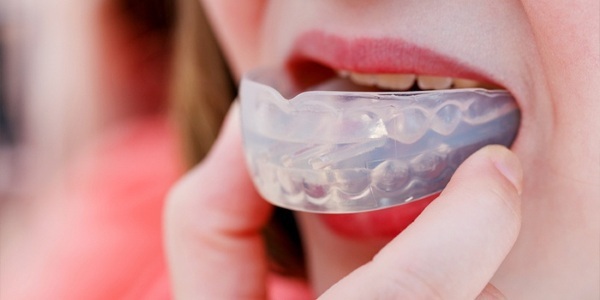
In most cases, if the problem does not apply to the field of dentistry, these measures help prevent tooth damage, but do not eliminate the causes of the syndrome.
Gum massage
Often, gum massage is prescribed as part of a comprehensive treatment for periodontitis and gingivitis. Depending on the degree of damage to the gums and teeth, it is carried out either at home or in a dental office using special equipment. This procedure is carried out using various techniques and requires a mandatory preliminary consultation with a dentist.
There are several types of gum massage:
- vacuum. It is performed by the dentist using special vacuum tubes. The negative pressure they exert on the gums stimulates the circulation of blood and lymph in the periodontal tissues. The therapeutic effect is due to the damaging effect on the capillaries, as a result of which the number of immune cells in the lesion increases and regeneration mechanisms are triggered;
- hydromassage. Carried out at home, using an irrigator. Water, or a medicinal solution, is supplied under pressure, helping to cleanse the entire oral cavity, including the most inaccessible areas;
- finger massage. The thumb and forefinger are placed on either side of the dentition. Light stroking movements massage the gums from bottom to top - for the upper teeth and from top to bottom - for the lower ones. Then, with circular movements of the index finger, massage the gums on each side, starting from the far edge of the teeth. The duration of the procedure is no more than 5 minutes;
- massage with a brush. The brush is placed at an angle of 45 ° to the dentition and with light circular movements is carried along the line of contact between the gums and teeth. Then it is carried out in a circular motion in the area of the roots of the teeth, slightly pressing with a brush. The procedure is recommended to be carried out using medicinal pastes or balms. Use only a soft brush previously steamed in hot boiled water.
Loose teeth in an adult (the dentist will help determine the reasons) is not always painful. Gum massage is indicated not only as a therapeutic, but also as a prophylactic agent for the prevention of gingivitis and periodontitis.
Folk remedies
As a prophylaxis of such diseases as gingivitis and periodontitis, as well as supportive therapy in their treatment, traditional medicine is used, which can be easily prepared at home:
- propolis tincture. Dissolve 20 drops of the tincture in a glass of warm boiled water. With this solution, you can make "baths", or rinse your mouth 4-5 times a day. For localized inflammation, apply sterile gauze soaked in solution for 10-15 minutes;
- tincture of celandine. Finely chop the celandine leaves and fill a liter jar with them. Pour in vodka or alcohol and leave to infuse in a dark place for about 2 weeks. For rinsing, the tincture is diluted with boiled water in a ratio of 1: 2. Rinse your mouth for 10 minutes 2-3 times a day after meals;
-
decoction of oak bark. Pour a tablespoon of chopped oak bark with a glass of boiling water and let it languish in a water bath. Cook over low heat for 5-7 minutes. Cool down. Strain the broth and dilute in a glass of water to full volume. Rinse 3-5 times a day.
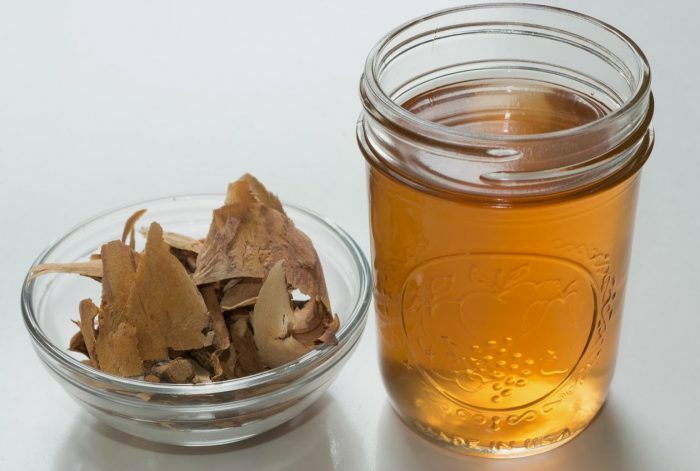
Slight tooth mobility is the norm in childhood and adolescence. When adults have teeth loose for no apparent reason, this is a sign of latent pathological processes occurring in the dentoalveolar system, or other systems and parts of the body. A timely visit to the dentist will help to avoid complications and preserve the integrity and health of teeth.
Dental Disease Videos
Why teeth swing and what to do:



